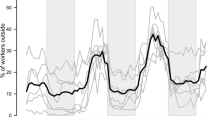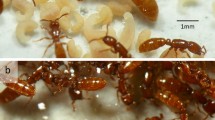Abstract
Division of labor was studied in incipient colonies of the dampwood termite Zootermopsis angusticollisby recording repertoire size, behavior frequencies, and time budgets of larvae. Behavioral repertoire size increased with age: first- and secondinstar larvae were mainly inactive, whereas larvae of the third through seventh instars performed 64–100% of all tasks. The increase in repertoire size from the second to the third instar was abrupt; repertoire size and composition remained more or less constant for older instars. No correlation between age (instars III–VII) and tasks was identified, suggesting that colony labor is performed by a single functional caste that spans the third to the seventh instar without any age-based division of labor. Small colony size, low oviposition rate, simple nest architecture, a lack of spatial association of tasks, and the potential for attaining reproductive status appear to be associated with the lack of age-related behavioral specialization in Z. angusticollis.In effect, the absence of temporal polyethism in this species is likely a consequence of its nesting habits and physiological and developmental constraints.
Similar content being viewed by others
References
Badertscher, S., Gerber, C., and Leuthold, R. H. (1983). Polyethism in food supply and processing in termite colonies ofMacrotermes subhyalinus (Isoptera).Behav. Ecol. Sociobiol. 12: 115–119.
Billen, J., Leuthold, R. H., and Joye, L. (1987). Salivary gland morphology related to polyethism in the termiteMacrotermes bellicosus. Proc. 11th Int. Congr. IUSSI, Munich, 1986. In Eder, J., and Rembold, H. (eds.)Chemistry and Biology of Social Insects, Peperny, Munich, p. 415.
Calabi, P., Traniello, J. F. A., and Werner, M. H. (1983). Age polyethism: Its occurrence in the antPheidole hortensis, and some general considerations.Psyche 85: 395–412.
Castle, G. B. (1934). The dampwood termites of western United States, genusZootermopsis (formerlyTermopsis) In Kofoid, C. A. (ed.),Termites and Termite Control, University of California Press, Berkeley, pp. 273–310.
Fagen, R. M., and Goldman, R. N. (1977). Behavioural catalogue analysis methods.Anim. Behav. 25: 261–271.
Garnier-Sillam, E. (1983a). Le polyethisme chezReticulitermes lucifugus santoniensis (Isoptera, Rhinotermitidae). A. Differences d'activites des ouvrier en fonction des stades.Insectes Soc. 30: 9–26.
Garnier-Sillam, E. (1983b). Le polyethisme chezReticulitermes lucifugus santoniensis (Isoptera, Rhinotermitidae). B. Contribution à l'étude du comportement individuel de prospection et de recrutaient lors de la recherche de nourriture chez les ouvriers.Insectes Soc. 30: 27–44.
Gerber, C., Badertscher, S., and Leuthold, R. H. (1988). Polyethism inMacrotermes bellicosus (Isoptera).Insectes Soc. 35: 226–240.
Heidecker, L., and Leuthold, R. H. (1984). The organisation of collective foraging in the harvester termiteHodotermes mossambicus (Isoptera).Behav. Ecol. Sociobiol. 14: 195–202.
Higashi, M., Yamamura, N., Abe, T., and Burns, T. P. (1991). Why don't all termites species have a sterile caste?Proc. R. Soc. Lond. B 246: 25–29.
Howse, P. E. (1968). On the division of labour in the primitive termiteZootermopsis nevadensis Hagen.Insectes Soc. 15: 45–50.
Jones, R. J. (1980). Gallery construction byNasusitermes costalis: Polyethism and the behavior of individuals.Insectes Soc. 27: 5–28.
Leuthold, R. H., Badertscher, S., and Imboden, H. (1989). The inoculation of newly formed fungus comb withTermitomyces inMacrotermes colonies (Isoptera, Macrotermitinae).Insectes Soc. 36: 328–338.
McMahan, E. A. (1970). Polyethism in workers ofNasutitermes costalis (Holmgren).Insectes Soc. 17: 113–120.
McMahan, E. A. (1979). Temporal polyethism in termites.Sociobiology 4: 153–168.
Miller, M. E. (1969). Caste differentiation in the lower termites. In Krishna, K., and Weesner, F.M. (eds.),Biology of Termites, Vol. 1, Academic Press, New York, pp. 283–310.
Nel, J. J. C., Hewitt, P. H., and Smith, L. J. (1969). The behaviour of the harvester termite (Hodotermes mossambicus Hagen) in a laboratory colony.J. Entomol. Soc. Afr. 32: 9–24.
Noirot, C. H. (1969). Formation of castes in higher termites. In Krishna, K., and Weesner, F. M. (eds.),Biology of Termites, Vol. 1, Academic Press, New York, pp. 311–350.
Noirot, C. H. (1970). The nests of termites. In Krishna, K., and Weesner, F. M. (eds.),Biology of Termites, Vol. 2, Academic Press, New York, pp. 73–125.
Noirot, C. H. (1985a). Pathways of caste development in the lower termites. In Watson, J. A. L., Okot-Kotber, B. M., and Noirot, C. H. (eds.),Caste Differentiation in Social Insects, Pergamon Press, New York, pp. 41–57.
Noirot, C. H. (1985b). The caste system in higher termites. In Watson, J. A. L., Okot-Kotber, B.M., and Noirot, C. H. (eds.),Caste Differentiation in Social Insects, Pergamon Press, New York, pp. 75–86.
Noirot, C. H., and Pasteels, J. M. (1987). Ontogenetic development and evolution of the worker caste in termites.Experientia 43: 851–952.
Noirot, C. H., and Pasteels, J. M. (1988). The worker caste is polyphyletic in termites.Sociobiology 14: 15–20.
Nutting, W. L. (1969). Flight and colony foundation. In Krishna, K., and Weesner, F. M. (eds.),Biology of Termites, Vol. 1, Academic Press, New York, pp. 233–282.
Oster, G. F., and Wilson, E. O. (1978).Caste and Ecology in the Social Insects, Princeton University Press, Princeton, NJ.
Otto, D. (1958). Uber die arbegitseilung im staate vonFormica rufa rufo-pratensis minor Gossw. und ihre verhalten-physiologischen Grundlagen: Ein Beitrag zur Biologie der roten Waldameise.Wiss. Abh. Adtsch. Akad. Landwirtschaftswiss. Berlin 30: 1–169.
Pasteels, J. M. (1965). Polyethism chez les ouvriers deNasutitermes lujae (Termitidae, Isopteres).Biol. Gabonica 1: 191–205.
Rice, W. R. (1989). Analyzing tables of statistical tests.Evolution 43: 223–225.
Roisin, Y. (1988a). Morphology, development and evolutionary significance of the working stages in the caste system ofProrhinotermes (Insecta, Isoptera).Zoomorphology 107: 339–347.
Roisin, Y. (1988b). The caste system ofProrhinotermes browni (Isoptera: Rhinotermitidae).Sociobiology 14: 21–28.
Rosengaus, R. B. (1992).Kinship, Social Organization, and Colony Dynamics in the Primitive Dampwood Termite Zootermopsis angusticollis, Ph.D. thesis, Boston University, Boston.
Rosengaus, R. B., and Traniello, J. F. A. (1991). Biparental care in incipient colonies of the dampwood termiteZootermopsis angusticoilis Hagen.J. Insect Behav. 4: 633–647.
Rosengaus, R. B., and Traniello, J. F. A. (1992). Disease risk as a cost of outbreeding in the termiteZootermopsis angusticoilis HagenPrac. Natl. Acad. Sci. (USA) (in press).
Seeley, T. D. (1982). Adaptive significance of the age polyethism schedule in honeybee colonies.Behav. Ecol. Sociobiol. 11: 287–293.
Sewell, J. J., and Watson, J. A. L. (1981). Developmental pathways in Australian species ofKalotermes Hagen (Isoptera).Sociobiology 6: 243–324.
Sieber, R., and Leuthold, R. H. (1981). Behavioral elements and their meaning in incipient laboratory colonies of the fungus-growing termiteMacrotermes michaelensi (Isoptera: Macrotermitinae).Insectes Soc. 28: 371–382.
Sokal, R. R., and Rholf, J. F. (1981).Biometry, W. H. Freeman, New York.
Stuart, A. M. (1969). Social behavior and communication. In Krishna, K., and Weesner, F. M. (eds.),Biology of Termites, Vol. 1, Academic Press, New York, pp. 193–232.
Traniello, J. F. A. (1978). Caste in a primitive ant: Absence of age polyethism inAmblyopone.Science 202: 770–772.
Watson, J. A. L. (1973). The worker caste of the Hodotermitid harvester termites.Insectes Soc. 20: 1–20.
Watson, J. A. L., and Sewell, J. J. (1985). Caste development in Mastotermes and Kalotermes: Which is primitive? In Watson, J. A. L., Okot-Kotber, B. M., and Noirot, C. H. (eds.).Caste differentiation in Social Insects, Pergamon Press, New York, pp. 27–40.
West-Eberhard, M. J. (1981). Intragroup selection and the evolution of insect societies. In Alexander, R. D., and Tinkle, D. W. (eds.),Natural Selection and Social Behavior, Chiron Press, New York, pp. 3–17.
Wheeler, D. E. (1986). Developmental and physiological determinants of caste in social Hymenoptera: Evolutionary implications.Am. Nat. 128: 13–34.
Wilson, E. O. (1971).The Insect Societies, Harvard University Press, Cambridge.
Wilson, E. O. (1976). Behavioral discretization and the number of castes in an ant species.Behav. Ecol. Sociobiol. 1: 141–154.
Wilson, E. O. (1985). The sociogenesis of insect colonies,Science 228: 1489–1495.
Yin, C. M. (1972).The Endocrine System and its Role in Caste Differentiation in the Lower Termite Zootermopsis angusticollisHagen, Ph.D. thesis, University of Saskatchewan, Saskatoon.
Author information
Authors and Affiliations
Rights and permissions
About this article
Cite this article
Rosengaus, R.B., Traniello, J.F.A. Temporal polyethism in incipient colonies of the primitive termiteZootermopsis angusticollis: A single multiage caste. J Insect Behav 6, 237–252 (1993). https://doi.org/10.1007/BF01051507
Accepted:
Issue Date:
DOI: https://doi.org/10.1007/BF01051507




